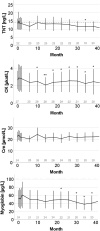Troponin T is elevated in a relevant proportion of patients with 5q-associated spinal muscular atrophy
- PMID: 38503830
- PMCID: PMC10951305
- DOI: 10.1038/s41598-024-57185-w
Troponin T is elevated in a relevant proportion of patients with 5q-associated spinal muscular atrophy
Abstract
Troponin T concentration (TNT) is commonly considered a marker of myocardial damage. However, elevated concentrations have been demonstrated in numerous neuromuscular disorders, pointing to the skeletal muscle as a possible extracardiac origin. The aim of this study was to determine disease-related changes of TNT in 5q-associated spinal muscular atrophy (SMA) and to screen for its biomarker potential in SMA. We therefore included 48 pediatric and 45 adult SMA patients in this retrospective cross-sequential observational study. Fluid muscle integrity and cardiac markers were analyzed in the serum of treatment-naïve patients and subsequently under disease-modifying therapies. We found a TNT elevation in 61% of SMA patients but no elevation of the cardiospecific isoform Troponin I (TNI). TNT elevation was more pronounced in children and particularly infants with aggressive phenotypes. In adults, TNT correlated to muscle destruction and decreased under therapy only in the subgroup with elevated TNT at baseline. In conclusion, TNT was elevated in a relevant proportion of patients with SMA with emphasis in infants and more aggressive phenotypes. Normal TNI levels support a likely extracardiac origin. Although its stand-alone biomarker potential seems to be limited, exploring TNT in SMA underlines the investigation of skeletal muscle integrity markers.
© 2024. The Author(s).
Conflict of interest statement
The authors declare no competing interests.
Figures



References
Publication types
MeSH terms
Substances
LinkOut - more resources
Full Text Sources
Medical

